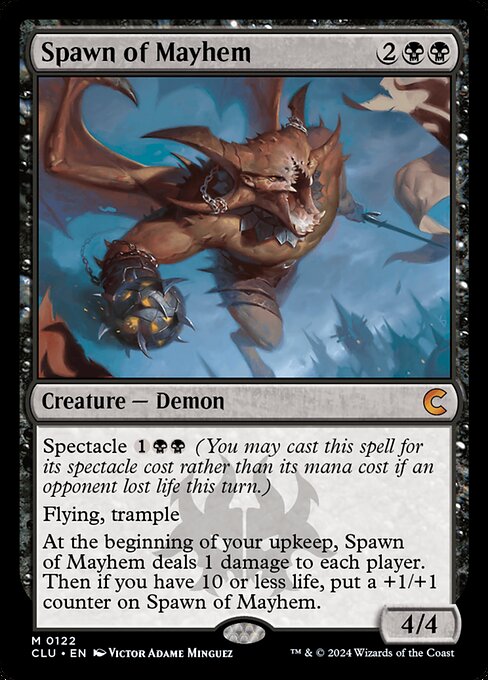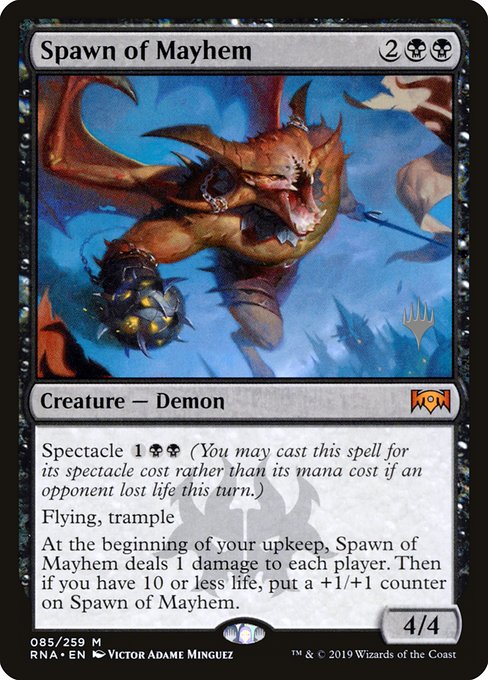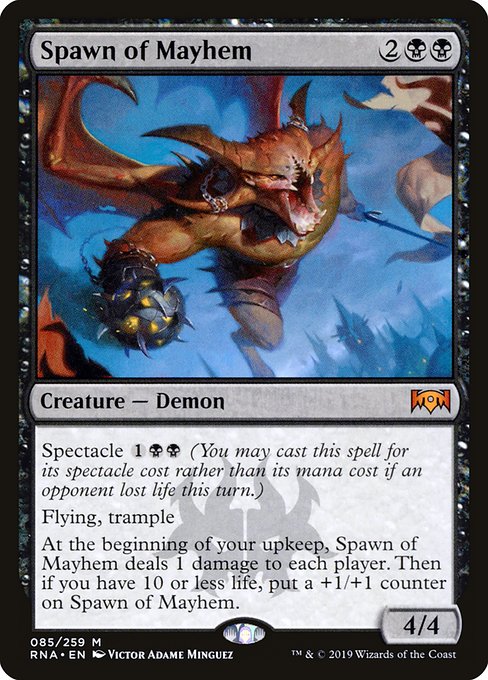Spawn of Mayhem
Creature — Demon
Spectacle (You may cast this spell for its spectacle cost rather than its mana cost if an opponent lost life this turn.)
Flying, trample
At the beginning of your upkeep, Spawn of Mayhem deals 1 damage to each player. Then if you have 10 or less life, put a +1/+1 counter on Spawn of Mayhem.
Flying, trample
At the beginning of your upkeep, Spawn of Mayhem deals 1 damage to each player. Then if you have 10 or less life, put a +1/+1 counter on Spawn of Mayhem.
4/4
standard
future
historic
gladiator
pioneer
explorer
modern
legacy
pauper
vintage
penny
commander
brawl
alchemy
paupercommander
duel
oldschool
premodern
Rulings
If each player has 0 life after Spawn of Mayhem’s triggered ability resolves, each player loses the game at the same time and the game ends in a draw.
A card’s spectacle cost is the same no matter how much life your opponents lost or how many opponents lost life.
If Spawn of Mayhem gains lifelink, the damage it deals will cause you to simultaneously lose and gain life. If your life total is 1, you won’t lose the game.
In a multiplayer game, if an opponent loses life and later that turn leaves the game, you can cast a spell for its spectacle cost. (If a player leaves the game during their turn, that turn continues without an active player.)
To determine the total cost of a spell, start with the mana cost or alternative cost you’re paying (such as a spectacle cost), add any cost increases, then apply any cost reductions. The converted mana cost of the spell remains unchanged, no matter what the total cost to cast it was.
In a Two-Headed Giant game, Spawn of Mayhem’s last ability causes each team to lose 2 life. Then if your team’s life total is 10 or less, you put a +1/+1 counter on Spawn of Mayhem.
Damage dealt to a player causes that player to lose that much life.
Spectacle doesn’t change when you can cast the card. For example, you can’t cast a sorcery with spectacle during an opponent’s turn unless another effect allows you to do so, even if that player has lost life this turn.
A card’s spectacle cost is the same no matter how much life your opponents lost or how many opponents lost life.
If Spawn of Mayhem gains lifelink, the damage it deals will cause you to simultaneously lose and gain life. If your life total is 1, you won’t lose the game.
In a multiplayer game, if an opponent loses life and later that turn leaves the game, you can cast a spell for its spectacle cost. (If a player leaves the game during their turn, that turn continues without an active player.)
To determine the total cost of a spell, start with the mana cost or alternative cost you’re paying (such as a spectacle cost), add any cost increases, then apply any cost reductions. The converted mana cost of the spell remains unchanged, no matter what the total cost to cast it was.
In a Two-Headed Giant game, Spawn of Mayhem’s last ability causes each team to lose 2 life. Then if your team’s life total is 10 or less, you put a +1/+1 counter on Spawn of Mayhem.
Damage dealt to a player causes that player to lose that much life.
Spectacle doesn’t change when you can cast the card. For example, you can’t cast a sorcery with spectacle during an opponent’s turn unless another effect allows you to do so, even if that player has lost life this turn.
Rulings
If each player has 0 life after Spawn of Mayhem’s triggered ability resolves, each player loses the game at the same time and the game ends in a draw.
A card’s spectacle cost is the same no matter how much life your opponents lost or how many opponents lost life.
If Spawn of Mayhem gains lifelink, the damage it deals will cause you to simultaneously lose and gain life. If your life total is 1, you won’t lose the game.
In a multiplayer game, if an opponent loses life and later that turn leaves the game, you can cast a spell for its spectacle cost. (If a player leaves the game during their turn, that turn continues without an active player.)
To determine the total cost of a spell, start with the mana cost or alternative cost you’re paying (such as a spectacle cost), add any cost increases, then apply any cost reductions. The converted mana cost of the spell remains unchanged, no matter what the total cost to cast it was.
In a Two-Headed Giant game, Spawn of Mayhem’s last ability causes each team to lose 2 life. Then if your team’s life total is 10 or less, you put a +1/+1 counter on Spawn of Mayhem.
Damage dealt to a player causes that player to lose that much life.
Spectacle doesn’t change when you can cast the card. For example, you can’t cast a sorcery with spectacle during an opponent’s turn unless another effect allows you to do so, even if that player has lost life this turn.
A card’s spectacle cost is the same no matter how much life your opponents lost or how many opponents lost life.
If Spawn of Mayhem gains lifelink, the damage it deals will cause you to simultaneously lose and gain life. If your life total is 1, you won’t lose the game.
In a multiplayer game, if an opponent loses life and later that turn leaves the game, you can cast a spell for its spectacle cost. (If a player leaves the game during their turn, that turn continues without an active player.)
To determine the total cost of a spell, start with the mana cost or alternative cost you’re paying (such as a spectacle cost), add any cost increases, then apply any cost reductions. The converted mana cost of the spell remains unchanged, no matter what the total cost to cast it was.
In a Two-Headed Giant game, Spawn of Mayhem’s last ability causes each team to lose 2 life. Then if your team’s life total is 10 or less, you put a +1/+1 counter on Spawn of Mayhem.
Damage dealt to a player causes that player to lose that much life.
Spectacle doesn’t change when you can cast the card. For example, you can’t cast a sorcery with spectacle during an opponent’s turn unless another effect allows you to do so, even if that player has lost life this turn.
Your collection? Your decks?
Want to manage your collection and/or create decks?


 0
0
 0.69€
0.69€

